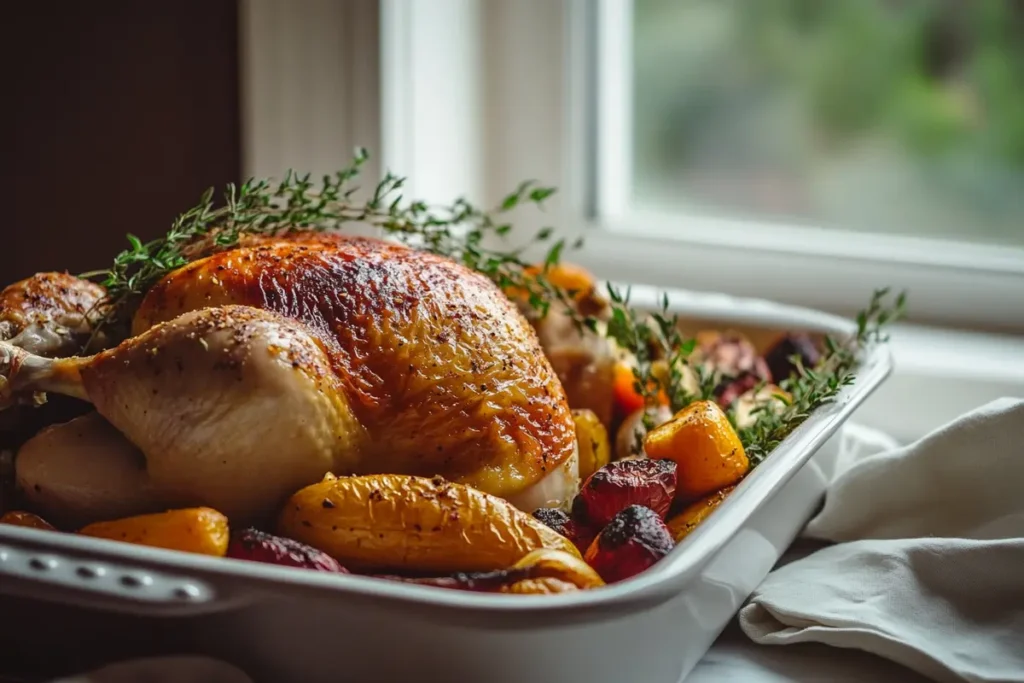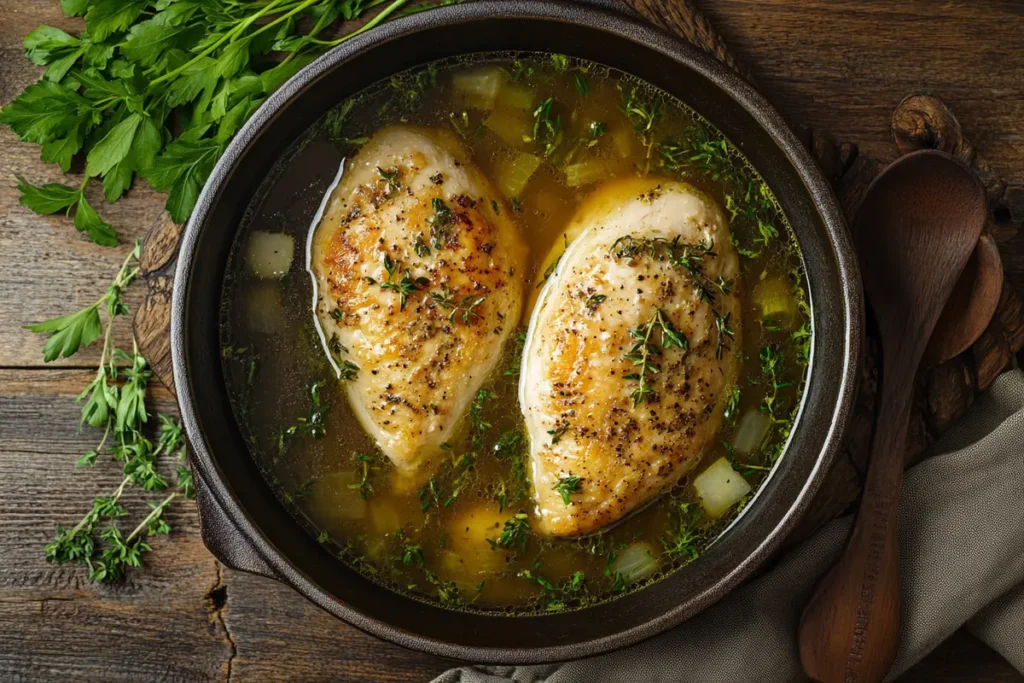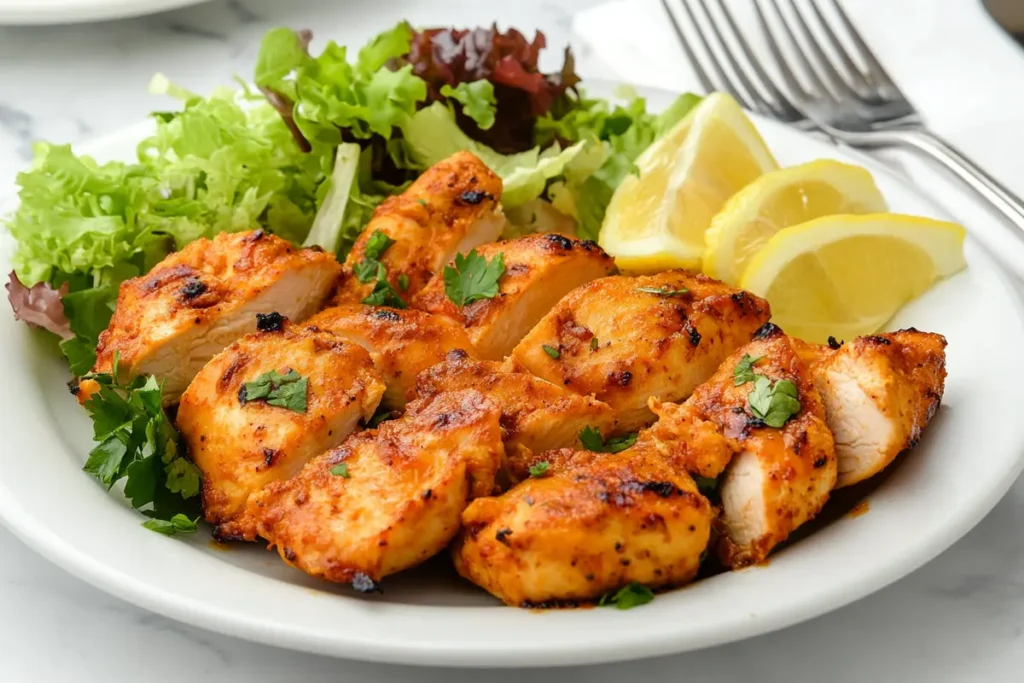Introduction
The Importance of Proper Cooking Times
Cooking chicken properly is essential for both safety and flavor. But how long does chicken take to cook? This depends on several factors, such as the cut, the cooking method, and whether it’s boneless or bone-in. Unlike other proteins, chicken must reach a safe internal temperature of 165°F (75°C) to kill harmful bacteria like Salmonella. Overcooking, however, can result in a dry and unappetizing meal. Striking the right balance is key.
By understanding how long it takes to cook different cuts and using proper techniques, you can achieve consistent, flavorful results every time.
Factors Affecting Cooking Duration
Several factors influence how long chicken takes to cook. These include:
- The cut of the chicken: Breasts, thighs, drumsticks, and wings each have unique cooking times due to their size and composition.
- Bone-in vs. boneless: Bone-in chicken typically takes longer to cook as the bone conducts heat more slowly.
- Skin-on vs. skinless: The skin insulates the meat, slightly extending the cooking time.
- Cooking method: Baking, grilling, boiling, slow cooking, and air frying all vary in the time required.
- Starting temperature: Cooking chicken straight from the refrigerator or freezer affects how long it takes to cook.
By mastering these factors, you can ensure your chicken is cooked perfectly, no matter the recipe.
Cooking Times Based on Chicken Cuts
Knowing how long each chicken cut takes to cook is critical to avoid undercooked or overdone results. Each cut differs in size, fat content, and composition, which directly impacts its cooking time. Let’s break it down.
Boneless, Skinless Chicken Breasts
Boneless, skinless chicken breasts are a popular choice for quick meals, but they’re notorious for drying out if overcooked.
- Baking: Preheat your oven to 400°F (200°C). Bake for 18–22 minutes, depending on thickness. Always check the internal temperature; it should reach 165°F (75°C).
- Grilling: Grill over medium heat for about 6–8 minutes per side. Flip only once to retain moisture, and learn more about how to keep chicken moist during cooking.
- Pan-Seared: Cook over medium-high heat for 5–7 minutes per side. A golden crust ensures flavor and seals in juices.
Bone-in, Skin-on Chicken Breasts
Bone-in, skin-on breasts take longer due to the bone and insulating effect of the skin. However, they offer rich flavor and a juicy texture when cooked correctly.
- Baking: At 375°F (190°C), bake for 35–40 minutes. Start with skin-side up to allow it to crisp.
- Grilling: Use indirect heat and grill for about 10–12 minutes per side, ensuring even cooking.
- Pan-Seared: Sear the skin side first for 4–5 minutes, then reduce the heat, cover, and cook for 20–25 minutes.
Chicken Thighs and Drumsticks
These dark meat cuts are more forgiving if overcooked, thanks to their higher fat content.
- Baking: Bake at 375°F (190°C) for 35–45 minutes. The bone-in variety may take closer to 45 minutes.
- Grilling: Cook thighs and drumsticks over medium heat for about 10–12 minutes per side.
- Slow Cooking: In a slow cooker, cook on low for 6–8 hours or on high for 3–4 hours. The meat should fall off the bone effortlessly.
Chicken Wings
Wings cook relatively quickly and are a favorite for appetizers or game-day meals.
- Baking: Bake at 425°F (220°C) for 25–30 minutes, flipping halfway through to ensure even crisping.
- Grilling: Grill over medium heat for 10–12 minutes, turning occasionally for a charred finish.
- Air Frying: Air fry at 400°F (200°C) for 20 minutes, shaking the basket every 5 minutes for evenly cooked wings.
Whole Chicken
Cooking a whole chicken is all about even heat distribution. It takes longer but yields tender meat and crispy skin.
- Baking: Roast at 375°F (190°C) for 20 minutes per pound. For example, a 4-pound chicken will take approximately 1 hour and 20 minutes. Ensure the thickest part of the breast and thigh reaches 165°F (75°C).
- Grilling: Spatchcock (butterfly) the chicken for more even cooking. Grill over indirect heat for 45–60 minutes.
- Slow Cooking: Cook on low for 6–8 hours or high for 4–5 hours. For a crispy skin, broil the chicken for 5–10 minutes after cooking.
By tailoring the cooking time to each cut, you’ll consistently achieve perfectly cooked chicken, full of flavor and juiciness.
Cooking Methods and Their Impact on Time
The method you choose to cook chicken significantly impacts how long it takes to reach the perfect temperature. Different techniques offer unique benefits, whether you’re looking for speed, flavor, or tenderness. Here’s a closer look at the most popular cooking methods.
Baking or Roasting: Cooking Times and Tips

Baking and roasting are versatile methods that work for all cuts, producing even cooking with minimal effort.
- Time and Temperature:
Boneless chicken breasts bake at 400°F (200°C) for 18–22 minutes, while a whole chicken requires 375°F (190°C) for 20 minutes per pound. - Best Practices:
Use a preheated oven and a lined baking tray for even heat distribution. Brushing chicken with oil or butter prevents it from drying out. - Ideal For:
Large batches or recipes where crispy skin and even cooking are desired.
Grilling: How Long to Grill Chicken for Perfect Results
Grilling adds a smoky, charred flavor that’s hard to beat. Check out these grilling chicken recipes for more ideas. It’s a fantastic choice for warm weather or quick meals.
- Time and Temperature:
Boneless chicken breasts cook over medium heat for about 6–8 minutes per side. For drumsticks and thighs, grill for 10–12 minutes per side. - Best Practices:
Preheat the grill and lightly oil the grates to prevent sticking. Marinate the chicken beforehand for enhanced flavor. - Ideal For:
Cuts like thighs, drumsticks, and wings, where the char complements the rich flavor of dark meat.
Poaching or Boiling: How Long Chicken Needs to Cook

Poaching is a gentle cooking method that ensures juicy, tender chicken, perfect for shredding or salads.
- Time and Temperature:
Bring a pot of water or broth to a gentle simmer (not boiling). Cook boneless breasts for 15–20 minutes and bone-in pieces for 30–40 minutes. - Best Practices:
Use enough liquid to fully submerge the chicken. Add aromatics like garlic, onions, or herbs to infuse flavor. - Ideal For:
Recipes where moist, shredded chicken is needed, such as soups or casseroles.
Slow Cooking
The slow cooker is a hands-off method that’s perfect for infusing deep flavors while tenderizing the meat. Explore some chicken slow-cooked recipes for inspiration.
- Time and Temperature:
Cook on low for 6–8 hours or high for 3–4 hours. Boneless cuts cook faster, while bone-in pieces take a bit longer. - Best Practices:
Avoid lifting the lid during cooking, as it releases heat and extends the cooking time. For crispier skin, broil the chicken briefly after cooking. - Ideal For:
Whole chickens, thighs, or drumsticks where tenderness is key.
Air Frying
Air frying is a relatively new method that delivers crispy results in less time than baking or frying.
- Time and Temperature:
Set the air fryer to 375°F (190°C). Cook wings, thighs, or drumsticks for 18–25 minutes, flipping halfway through. - Best Practices:
Avoid overcrowding the air fryer basket for even cooking. A light coating of oil enhances crispiness. - Ideal For:
Smaller cuts like wings or drumsticks that benefit from a crunchy exterior.
Searing in a Pan
Searing is a quick and flavorful option for boneless cuts, creating a golden crust and sealing in juices.
- Time and Temperature:
Cook over medium-high heat for 5–7 minutes per side. - Best Practices:
Use a heavy-bottomed skillet to maintain consistent heat. Rest the chicken for a few minutes after cooking to lock in juices. - Ideal For:
Boneless chicken breasts or thighs, especially for dishes like salads or sandwiches.
By choosing the right cooking method for your chicken cut, you can save time and enhance flavor while ensuring it’s perfectly cooked.
Ensuring Chicken is Properly Cooked

Cooking chicken to the correct doneness is non-negotiable for safety and flavor. It’s not just about cooking times but also knowing how to confirm the chicken is safe to eat. Let’s explore the key techniques for ensuring perfectly cooked chicken every time.
Using a Meat Thermometer
The most reliable way to check if chicken is cooked is by using a meat thermometer. This tool eliminates guesswork and ensures your chicken is neither undercooked nor overcooked.
- Internal Temperature Guidelines:
The safe internal temperature for all parts of chicken is 165°F (75°C). Insert the thermometer into the thickest part of the meat, avoiding the bone. - Checking Whole Chickens:
For a whole bird, check the temperature at the thickest part of the breast and the inner thigh. Both areas should reach 165°F (75°C). - Tips for Accuracy:
Allow the thermometer to rest for a few seconds for a stable reading. For digital thermometers, always calibrate before use if needed.
Visual Indicators of Doneness
While a thermometer is the gold standard, there are visual clues that can also help you determine if your chicken is cooked.
- Juices Run Clear:
Pierce the chicken with a fork or knife. If the juices run clear (not pink or reddish), the chicken is likely done. - Firm Texture:
Properly cooked chicken feels firm to the touch but not hard. Undercooked chicken will feel soft and slightly spongy. - Color Check:
The inside of the chicken should be white with no pinkish hue. However, the meat near bones may sometimes retain a slightly pink color even when fully cooked.
Resting Time After Cooking
Nutritional Information (Per 100g of Cooked Chicken)
| Nutrient | Amount |
|---|---|
| Calories | 165 kcal |
| Protein | 31 g |
| Fat | 3.6 g |
| Carbohydrates | 0 g |
| Cholesterol | 85 mg |
| Sodium | 74 mg |
| Iron | 0.9 mg |
Note: Nutritional values may vary slightly based on preparation method and seasoning.
Resting the chicken after cooking is a small but crucial step that enhances its flavor and texture.
- Why Resting Matters:
Resting allows the juices to redistribute within the meat, making it juicier and more flavorful. Skipping this step often leads to dry chicken as the juices spill out when cutting into it too soon. - How Long to Rest:
Rest small cuts like breasts or thighs for 5 minutes. For a whole chicken, allow 10–15 minutes before carving. Covering the chicken loosely with foil during resting helps retain heat. For tips on storing and reheating chicken, read here.
Avoiding Common Mistakes
- Cutting Too Early:
Slicing into chicken immediately after cooking causes the juices to escape, resulting in dry meat. - Skipping Temperature Checks:
Visual cues alone can sometimes be misleading. Always confirm doneness with a thermometer for accuracy. - Overcooking:
Cooking chicken beyond 165°F (75°C), especially lean cuts like breasts, leads to dryness. Monitor cooking times closely and check early.
By combining precise tools like a meat thermometer with practical techniques like resting and visual inspections, you’ll always end up with perfectly cooked, safe, and delicious chicken.
Frequently Asked Questions About How Long Chicken Takes to Cook
How can I tell if chicken is undercooked?
Undercooked chicken often has a soft, jelly-like texture and a slightly translucent or pinkish interior. Juices may appear reddish or pink when pierced. Always confirm doneness with a meat thermometer—the internal temperature should reach 165°F (75°C) to be safe.
Does marinating affect cooking time?
Yes, marinating can slightly alter cooking times. Marinades with high acid content (like lemon juice or vinegar) can tenderize chicken and slightly reduce the time needed, especially for thinner cuts. However, thick marinades may act as an insulator and increase cooking time.
Can I cook frozen chicken without thawing?
Yes, you can cook chicken directly from frozen, but it will take approximately 50% longer than cooking thawed chicken. For example, frozen boneless breasts baked at 400°F (200°C) may require 30–40 minutes instead of 18–22 minutes. Always ensure the internal temperature reaches 165°F (75°C).
How does altitude affect cooking times?
At higher altitudes, water boils at a lower temperature, which can increase cooking times for chicken. For methods like poaching or boiling, plan to cook for a few extra minutes. Baking times may also need slight adjustments. Use a meat thermometer to confirm doneness.
What are the risks of undercooked chicken?
Undercooked chicken can harbor harmful bacteria, such as Salmonella and Campylobacter, which can cause foodborne illnesses. Symptoms include nausea, diarrhea, and abdominal cramps. To avoid these risks, always cook chicken to a safe internal temperature.
Conclusion
Cooking chicken to perfection doesn’t have to be a guessing game. By understanding how different factors like cuts, cooking methods, and temperatures affect cooking times, you can consistently prepare chicken that’s not only safe to eat but also deliciously moist and flavorful.
From using a meat thermometer to mastering various cooking techniques, the key is attention to detail and patience. Whether you’re baking a whole chicken, grilling thighs, or air frying wings, following these guidelines will ensure a satisfying result every time.
Remember, safety comes first—always aim for an internal temperature of 165°F (75°C). But don’t stop there. Take the extra steps like resting your chicken and experimenting with methods that bring out the best in each cut. With this comprehensive guide, you’re well-equipped to cook chicken confidently and enjoy meals that delight your taste buds. Happy cooking!

